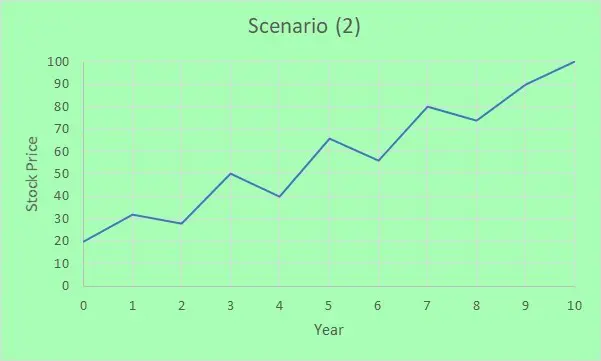November 10, 2024
As a long-term value investor, how does one maximize long-term returns? Being hyper-selective – choosing the top 0.1% of ideas – is essential.
But something else that is essential is bet sizing. There’s actually a simple mathematical formula – the Kelly criterion – that tells you exactly how much to bet in order to maximize your long-term returns.
Both Warren Buffett and Charlie Munger are proponents of the essential logic of the Kelly criterion: bet big when you have the odds, otherwise don’t bet. Here’s Charlie Munger:
The wise ones bet heavily when the world offers them that opportunity. They bet big when they have the odds. And the rest of the time, they don’t. It’s just that simple.
As for Buffett, he famously invested 40% of his hedge fund into American Express in the late 1960s. Buffett realized a large profit. Later, Buffett invested 25% of Berkshire Hathaway’s portfolio in Coca-Cola. Buffett again enjoyed a large profit of more than 10x (and counting).
Some history of the Kelly criterion:
Claude Shannon was a fascinating character–he often rode a unicycle while juggling, and his house was filled with gadgets. Shannon’s master’s thesis was arguably the most important and famous master’s thesis of the twentieth century. In it, he proposed binary digit or bit, as the basic unit of information. A bit could have only two values–0 or 1, which could mean true or false, yes or no, or on or off. This allowed Boolean algebra to represent any logical relationship. This meant that the electrical switch could perform logic functions, which was the practical foundation for all digital circuits and computers.
The mathematician Ed Thorp, a colleague of Shannon’s at MIT, had discovered a way to beat the casinos at blackjack. But Thorp was trying to figure out how to size his blackjack bets as a function of how favorable the odds were. Someone suggested to Thorp that he talk to Shannon about it. Shannon recalled a paper written by a Bell Labs colleague of his, John Kelly, that dealt with this question.
The Kelly criterion can be written as follows:
where
-
- F = Kelly criterion fraction of current capital to bet
- o = Net odds, or dollars won per $1 bet if the bet wins (e.g., the bet may pay 5 to 1, meaning you win $5 per each $1 bet if the bet wins)
- p = probability of winning
- q = probability of losing = 1 – p
The Kelly criterion has a unique mathematical property: if you know the probability of winning and the net odds (payoff), then betting exactly the percentage determined by the Kelly criterion leads to the maximum long-term compounding of capital, assuming that you’re going to make a long series of bets. Betting any percentage that is not equal to that given by the Kelly criterion will inevitably lead to lower compound growth over a long period of time.
Thorp proceeded to use the Kelly criterion to win quite a bit of money at blackjack, at least until the casinos began taking countermeasures such as cheating dealers, frequent reshuffling, and outright banning. But Thorp realized that the stock market was also partly inefficient, and it was a far larger game.
Thorp launched a hedge fund that searched for little arbitrage situations (pricing discrepancies) involving warrants, options, and convertible bonds. In order to size his positions, Thorp used the Kelly criterion. Thorp evolved his approach over the years as previously profitable strategies were copied. His multi-decade track record was terrific.
Ed Thorp examined Buffett’s career and concluded that Buffett has used the essential logic of the Kelly criterion by concentrating his capital into his best ideas. Buffett’s concentrated value approach has produced an outstanding, unparalleled 66-year track record.
Thorp has made several important points about the Kelly criterion as it applies to long-term value investing. The Kelly criterion was invented to apply to a very long series of bets. Value investing differs because even a concentrated value investing approach will usually have at least 5-8 positions in the portfolio at the same time. Thorp argues that, in this situation, the investor must compare all the current and prospective investments simultaneously on the basis of the Kelly criterion.
In The Dhandho Investor, Mohnish Pabrai gives an example showing how you can use the Kelly criterion on your top 8 ideas, and then normalize the position sizes.
Say you look at your top 8 investment ideas. You use the Kelly criterion on each idea separately to figure out how large the position should be, and this is what you conclude about the ideal bet sizes:
-
- Bet 1 – 80%
- Bet 2 – 70%
- Bet 3 – 60%
- Bet 4 – 55%
- Bet 5 – 45%
- Bet 6 – 35%
- Bet 7 – 30%
- Bet 8 – 25%
Of course, that adds up to 400%. Yet for a value investor, especially running a concentrated portfolio of 5-8 positions, it virtually never makes sense to buy stocks on margin. Leverage cannot make a bad investment into a good investment, but it can turn a good investment into a bad investment. So you don’t need any leverage. It’s better to compound at a slightly lower rate than to risk turning a good investment into a bad investment because you lack staying power.
So the next step is simply to normalize the position sizes so that they add up to 100%. Since the original portfolio adds up to 400%, you just divide each position by 4:
-
- Bet 1 – 20%
- Bet 2 – 17%
- Bet 3 – 15%
- Bet 4 – 14%
- Bet 5 – 11%
- Bet 6 – 9%
- Bet 7 – 8%
- Bet 8 – 6%
(These percentages are rounded for simplicity.)
As mentioned earlier, if you truly know the odds of each bet in a long series of bets, the Kelly criterion tells you exactly how much to bet on each bet in order to maximize your long-term compounded rate of return. Betting any other amount will lead to lower compound returns. In particular, if you repeatedly bet more than what the Kelly criterion indicates, you eventually will destroy your capital.
It’s nearly always true when investing in a stock that you won’t know the true odds or the true future scenarios. You usually have to make an estimate. Because you never want to bet more than what the Kelly criterion says, it is wise to bet one half or one quarter of what the Kelly criterion says. This is called half-Kelly or quarter-Kelly betting. What is nice about half-Kelly betting is that you will earn three-quarters of the long-term returns of what full Kelly betting would deliver, but with only half the volatility.
So in practice, if there is any uncertainty in your estimates, you want to bet half-Kelly or quarter-Kelly. In the case of a concentrated portfolio of 5-8 stocks, you will frequently end up betting half-Kelly or quarter-Kelly because you are making 5-8 bets at the same time. In Mohnish’s example, you end up betting quarter-Kelly in each position once you’ve normalized the portfolio.
When running the Buffett Partnership, Warren Buffett invested 40% of the partnership in American Express after the stock had been cut in half following the salad oil scandal. American Express had to announce a $60 million loss, a huge hit given its total market capitalization of roughly $150 million at the time. But Buffett determined that the essential business of American Express–travelers’ checks and charge cards–had not been permanently damaged. American Express still had a very valuable moat.
Buffett explained his reasoning in several letters to limited partners:
We might invest up to 40% of our net worth in a single security under conditions coupling an extremely high probability that our facts and reasoning are correct with a very low probability that anything could change the underlying value of the investment.
We are obviously only going to go to 40% in very rare situations–this rarity, of course, is what makes it necessary that we concentrate so heavily, when we see such an opportunity. We probably have had only five or six situations in the nine-year history of the partnerships where we have exceeded 25%. Any such situations are going to have to promise very significant superior performance… They are also going to have to possess such superior qualitative and/or quantitative factors that the chance of serious permanent loss is minimal…
There’s virtually no such thing as a sure bet in the stock market. But there are situations where the odds of winning are very high or where the potential upside is substantial.
One final note: In constructing a concentrated portfolio of 5-8 stocks, if at least some of the positions are non-correlated or even negatively correlated, then the volatility of the overall portfolio can be reduced. Some top investors prefer to have about 15 positions with low correlations. Ray Dalio does this.
Once you get to at least 25 positions, specific correlations typically tend not to be an issue, although some investors may end up concentrating on specific industries. In fact, it often may make sense to concentrate on industries that are deeply out-of-favor.
Mohnish concludes:
…It’s all about the odds. Looking out for mispriced betting opportunities and betting heavily when the odds are overwhelmingly in your favor is the ticket to wealth. It’s all about letting the Kelly Formula dictate the upper bounds of these large bets. Further, because of multiple favorable betting opportunities available in equity markets, the volatility surrounding the Kelly Formula can be naturally tamed while still running a very concentrated portfolio.
In sum, top value investors like Warren Buffett, Charlie Munger, and Mohnish Pabrai–to name just a few out of many–naturally concentrate on their best 5-8 ideas, at least when they’re managing a small enough amount of money. (These days, Berkshire’s portfolio is massive, which makes it much more difficult to concentrate, let alone to find hidden gems among microcap stocks.)
You have to take a humble look at your strategy and your ability before deciding on your level of concentration. The Boole Microcap Fund that I manage is designed to focus on the top 5-8 ideas. This is concentrated enough so that the best performers–whichever stocks they turn out to be–can make a difference to the portfolio. But it is not so concentrated that it misses the best performers. In practice, the best performers very often turn out to be idea #5 or idea #8, rather than idea #1 or idea #2. Many top value investors–including Peter Cundill, Joel Greenblatt, and Mohnish Pabrai–have found this to be true.
BOOLE MICROCAP FUND
An equal weighted group of micro caps generally far outperforms an equal weighted (or cap-weighted) group of larger stocks over time. See the historical chart here: https://boolefund.com/best-performers-microcap-stocks/
This outperformance increases significantly by focusing on cheap micro caps. Performance can be further boosted by isolating cheap microcap companies that show improving fundamentals. We rank microcap stocks based on these and similar criteria.
There are roughly 10-20 positions in the portfolio. The size of each position is determined by its rank. Typically the largest position is 15-20% (at cost), while the average position is 8-10% (at cost). Positions are held for 3 to 5 years unless a stock approachesintrinsic value sooner or an error has been discovered.
The mission of the Boole Fund is to outperform the S&P 500 Index by at least 5% per year (net of fees) over 5-year periods. We also aim to outpace the Russell Microcap Index by at least 2% per year (net). The Boole Fund has low fees.





